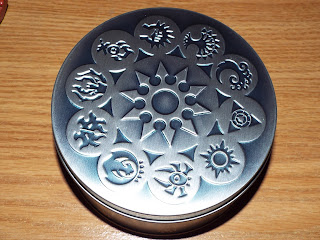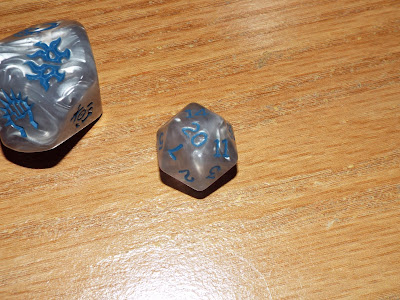Review copy courtesy of Wizards of the Coast.
Pros
- Lots of full colour art as always. This one in particular has some very beautiful maps and location illustrations. There is some that is too cartoony for my taste though.
- The overarching sequence of events that make up the campaign make sense.
- The setting on this one is a particular highlight. The large presence of devils, and being in hell make the scenario and situation vastly different than just another kingdom. Lots of lying and manipulation on this.
- It's a darker adventure with great atmosphere.
- The idea of having the characters pick a dark secret is a good one. It ties the players and characters together and gives the Dungeon Master some good leverage. But you’ll need to get buy-in from your players as it affects their characters.
- The section on devil deals is very nice. Making deals and tempting players is one of the best parts of playing devils.
Could Go Either Way
- Curse of Strahd wasted no time in throwing players into the new setting. Here, there’s a bit of buildup. It starts off in Baldur’s Gate and works up to hell.
- It can get weird. Giant infernal war machines, experiencing dreams, talking to the damned. If “trying to escape a level of hell” is your cup of tea, you’ll get a lot of fun out of the otherness of the setting.
- I wouldn’t recommend this for new Dungeon Masters unless the concept really grabs you, and you’re comfortable with playing things by ear.
- The connective tissue between certain parts, in particularly the intro, can be a bit rough.
- It’s the standard ~250 page adventure. I think they could push it to 300 but hey, we know what to expect by now from these. This is especially true since only about 150 pages are really detailing the adventure. The rest are creatures (some of which are repeats from other books), detail on Baldur’s Gate,
- About 50 pages of the 256 pages are just describing Baldur’s Gate as it is today. This can be useful for the Dungeon Master, but the real interesting part is in Avernus. I would’ve liked more detailed for the adventure itself. The Baldur’s Gate stuff, while interesting, I feel should have been available in their online magazine or something to give more pages to the adventure itself.
Cons
- No PDF*
* Denotes nitpicking.
 |
| Baldur's Gate: Descent Into Avernus Cover |
Introduction
We’ve
got another D&D adventure on our hands. This new one called
“Baldur’s Gate: Descent to Avernus”, as the name suggests,
heavily features one of the lawyers of hell. Going from the surface
work to being trapped in hell and needing to find a way out, it
provides a quite
unique experience as players meet, negotiate and fight with devils.
Perhaps
it’s the subject matter, in fact I’m sure that’s a big part of
it, but I think this is my favourite adventure since Curse
of Strahd.
At
the time of writing I’ve run the first two chapters. It
still requires some adaptation, so I wouldn’t recommend it for new
Dungeon Masters, but it makes me want to adapt and run it.
 |
| Descent Into Avernus concept art example. |
The Adventure
New Player Options
Nope. Not much here. There’s a few
pages for a new background, and some twists on existing ones. Beyond
that though? Nope.
New Monsters
There’s only a
handful of new creatures. The rest are existing ones from previously
released books. That makes sense to me since we are talking about
devils which already got their time in the limelight in this edition.
And devils are a lot of fun. Probably my second favourite kind of
creature after undead.
What You Need to Play
The Monster Manual, Player's
Handbook and Dungeon Master's Guide are referenced at the
start of the adventure. You know what that means.
If you’re not a D&D
expert, I wouldn’t recommend trying to run it without at least the
Monster Manual. I
really which they weren’t necessary, but here we are.
 |
| An example of the sort of art you can expect. Pictured here is Candlekeep. |
The Adventure Itself (Some Spoilers)
The
basic idea of this adventure is really solid, and one of my
favourites in a long while. Running around a layer of hell is the
kind of quality idea that good campaigns are made of. Doing
so with the lives of a city
on the line, while dealing with devil contracts, and having the
possibility to redeem an archdevil just makes things more fun.
One
thing to note is that the adventure eases players into being in hell.
It doesn’t just throw them
in and watches them sink or swim like Curse of Strahd.
Instead they start in
Baldur’s Gate and see the strife created by one of the symptoms of
the devils actions. Then,
they get dragged there and exposed to the new set of rules present
in Avernus.
A
fair number of pages are
given to help Dungeon Masters with making contracts as well as the
procedure around them. Not all of them are simply written on paper,
and many alternative options such as even singing a song are
presented. I’m very happy to see that sort of thing as even if not
used, it helps to stoke
ideas.
A
rather large number of important parts of this adventure also take
place in memories. This makes the adventure even more surreal and
odd. It also allows for the
characters to participate in more situation and see exciting
information first hand. However, it’s something you should know
before running in case it’s the sort of thing you don’t like.
I’ve played with quite a
few people who wanted everything to happen in the real, waking world.
While
not necessary, I think some knowledge about the different devils of
the hells as well as some background knowledge of the blood war would
be helpful. It is an important part of backdrop and if you don’t
have a firm grasp on it, it’s all the harder to communicate it
effectively to your players.
I
wish there was more devoted to the possible final fight at the end of
the adventure with an archdevil. A battle
map or sketch of the area
with some turn order events would have made it much easier to run,
especially for new Dungeon Masters. I
also find some basic suggestions like this extremely helpful to get
an idea of the intended character of creatures and how they approach
a fight.
 |
| One of my favourite pictures from this adventure. Baldur's Gate in all of its splendour. |
The Art and Book Build Quality
The build quality
of the book is what we’ve come to expect. It’s the same style as
usual, except for the limited edition cover. I’m also happy to
report that my copy was flawless. However, I’ve seen enough issues
in this edition to still recommend that if you are picking up the
book in person, just flip through it to make sure there aren’t any
obvious issues.
The art ranges from
so amazing it makes my list of favourite illustrations in this
edition, to decent but not my style. I’d hang some of the scenery
illustrations on my walls. They’re that good. The maps too are
absolutely amazing. The Baldur’s Gate section, while I think
unnecessary in an adventure book, has some very nice 3D perspective
illustrations. A lot of the art is nicely coloured, unlike some
previous books that were mostly black and white. There are some
pieces that look like stained glass windows and wow, they are some of
my favourite pieces from this book.
 |
| The stained glass style I mentioned in the art style section above. I really like this. |
Price
You all know the drill by now. It’s
the standard price for a D&D adventure ($50 in the States and $64
in Canada). For the suggested retail price of this product, you can
check here.
You can find it cheaper if you look online, but I’ll let you all
decide who you want to support with your purchases.
What I felt was Missing
This adventure is almost begging to be
a series. A Dante’s Inferno style trek through the levels of hell.
One level is big enough for a full campaign, sure, but still it makes
me yearn for more. I guess that’s a good sign.
The book includes a section which
features concept art for the book. Some of it is very nice looking,
but I think it could be better organized, I’d love to see more, and
I’d want it out of the book if possible. Put it in the magazine to
help sell the adventure. Give me more pages for the adventure.
Especially when I’d liked to have some professionally thought up
contingencies for if players do something slightly different than the
adventure. Yes, players will often find out of the box solutions, but
at the very least have an obvious alternative if the player
characters don’t want to try to kill or kidnap someone.
Free Stuff
Nope. Sorry.
Nothing to see here. I know, I’m disappointed too.
Summary
I said it in the intro, but I really do
think this may be my second favourite adventure in this edition after
Curse of Strahd. The
art in places is absolutely stunning, the concept is easy to have fun
with, and the maps... oh my the maps look amazing. However, I wish
more of the book details the adventure and creatures. What if you
want to set it in your own setting instead of Baldur’s Gate? Well,
there go 50 pages unused.
If I’m making a new setting
or using my own existing
setting I’ve developed in my time playing the game, I can work from
the adventure. However, it’d
be nice if it wasn’t so strongly assumed to be set in the forgotten
realms.













